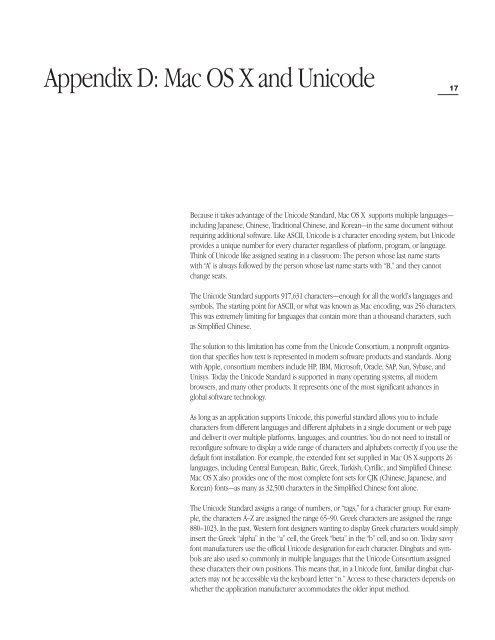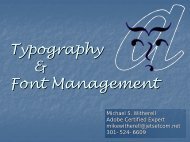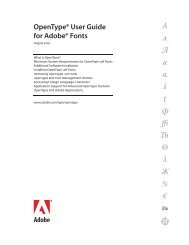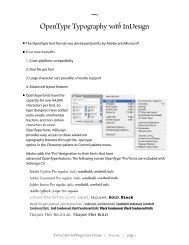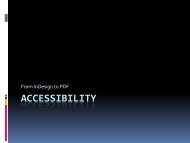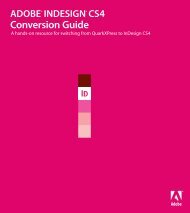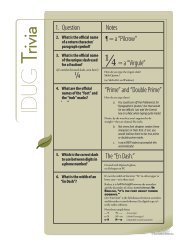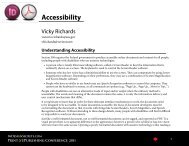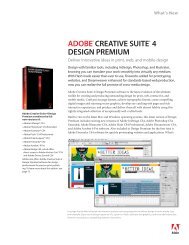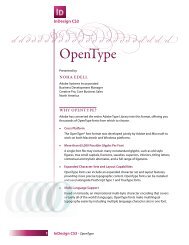Using and Managing Fonts in Mac OS X - UC Davis Department of ...
Using and Managing Fonts in Mac OS X - UC Davis Department of ...
Using and Managing Fonts in Mac OS X - UC Davis Department of ...
Create successful ePaper yourself
Turn your PDF publications into a flip-book with our unique Google optimized e-Paper software.
Appendix D: <strong>Mac</strong> <strong>OS</strong> X <strong>and</strong> Unicode<br />
17<br />
Because it takes advantage <strong>of</strong> the Unicode St<strong>and</strong>ard, <strong>Mac</strong> <strong>OS</strong> X supports multiple languages—<br />
<strong>in</strong>clud<strong>in</strong>g Japanese, Ch<strong>in</strong>ese, Traditional Ch<strong>in</strong>ese, <strong>and</strong> Korean—<strong>in</strong> the same document without<br />
requir<strong>in</strong>g additional s<strong>of</strong>tware. Like ASCII, Unicode is a character encod<strong>in</strong>g system, but Unicode<br />
provides a unique number for every character regardless <strong>of</strong> platform, program, or language.<br />
Th<strong>in</strong>k <strong>of</strong> Unicode like assigned seat<strong>in</strong>g <strong>in</strong> a classroom: The person whose last name starts<br />
with “A” is always followed by the person whose last name starts with “B,” <strong>and</strong> they cannot<br />
change seats.<br />
The Unicode St<strong>and</strong>ard supports 917,631 characters—enough for all the world’s languages <strong>and</strong><br />
symbols. The start<strong>in</strong>g po<strong>in</strong>t for ASCII, or what was known as <strong>Mac</strong> encod<strong>in</strong>g, was 256 characters.<br />
This was extremely limit<strong>in</strong>g for languages that conta<strong>in</strong> more than a thous<strong>and</strong> characters, such<br />
as Simplified Ch<strong>in</strong>ese.<br />
The solution to this limitation has come from the Unicode Consortium, a nonpr<strong>of</strong>it organization<br />
that specifies how text is represented <strong>in</strong> modern s<strong>of</strong>tware products <strong>and</strong> st<strong>and</strong>ards. Along<br />
with Apple, consortium members <strong>in</strong>clude HP, IBM, Micros<strong>of</strong>t, Oracle, SAP, Sun, Sybase, <strong>and</strong><br />
Unisys. Today the Unicode St<strong>and</strong>ard is supported <strong>in</strong> many operat<strong>in</strong>g systems, all modern<br />
browsers, <strong>and</strong> many other products. It represents one <strong>of</strong> the most significant advances <strong>in</strong><br />
global s<strong>of</strong>tware technology.<br />
As long as an application supports Unicode, this powerful st<strong>and</strong>ard allows you to <strong>in</strong>clude<br />
characters from different languages <strong>and</strong> different alphabets <strong>in</strong> a s<strong>in</strong>gle document or web page<br />
<strong>and</strong> deliver it over multiple platforms, languages, <strong>and</strong> countries. You do not need to <strong>in</strong>stall or<br />
reconfigure s<strong>of</strong>tware to display a wide range <strong>of</strong> characters <strong>and</strong> alphabets correctly if you use the<br />
default font <strong>in</strong>stallation. For example, the extended font set supplied <strong>in</strong> <strong>Mac</strong> <strong>OS</strong> X supports 26<br />
languages, <strong>in</strong>clud<strong>in</strong>g Central European, Baltic, Greek, Turkish, Cyrillic, <strong>and</strong> Simplified Ch<strong>in</strong>ese.<br />
<strong>Mac</strong> <strong>OS</strong> X also provides one <strong>of</strong> the most complete font sets for CJK (Ch<strong>in</strong>ese, Japanese, <strong>and</strong><br />
Korean) fonts—as many as 32,500 characters <strong>in</strong> the Simplified Ch<strong>in</strong>ese font alone.<br />
The Unicode St<strong>and</strong>ard assigns a range <strong>of</strong> numbers, or “tags,” for a character group. For example,<br />
the characters A–Z are assigned the range 65–90. Greek characters are assigned the range<br />
880–1023. In the past, Western font designers want<strong>in</strong>g to display Greek characters would simply<br />
<strong>in</strong>sert the Greek “alpha” <strong>in</strong> the “a” cell, the Greek “beta” <strong>in</strong> the “b” cell, <strong>and</strong> so on. Today savvy<br />
font manufacturers use the <strong>of</strong>ficial Unicode designation for each character. D<strong>in</strong>gbats <strong>and</strong> symbols<br />
are also used so commonly <strong>in</strong> multiple languages that the Unicode Consortium assigned<br />
these characters their own positions. This means that, <strong>in</strong> a Unicode font, familiar d<strong>in</strong>gbat characters<br />
may not be accessible via the keyboard letter “n.” Access to these characters depends on<br />
whether the application manufacturer accommodates the older <strong>in</strong>put method.


